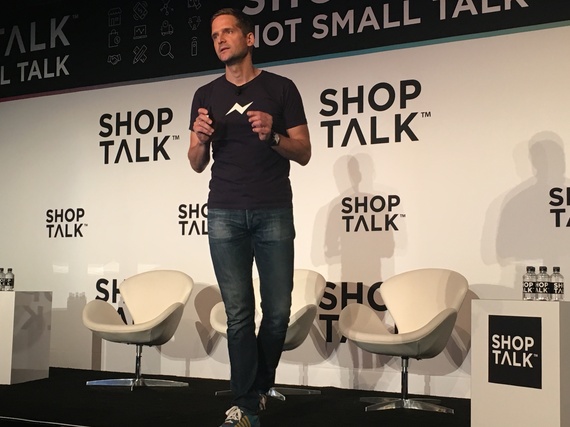Here's the only rock-solid prediction you'll read in this whole piece: After any big retail show, like last week's Shoptalk 2016, a spate of stories predicting the future of retail will appear.
There. Got one right.
Seriously, retail is in the midst of dramatic disruption, fueled by technology, data and competition from entrepreneurs who are turning to lean startup ideas to launch companies that appeal to an ever-more-diverse and demanding customer base.
When thinking about what retail will look like in the coming years, it helps to think about how quickly the industry has changed in the years just passed.
"It's only been 20 years ago, that the only way that you could actually buy a product, is that you walked into a store, talked to one of the shop representatives, and picked it up," Facebook's Frerk-Malte Feller said during a Shoptalk presentation of Messenger's latest e-commerce capabilities.
With that in mind, here are three trends, much discussed at Shoptalk, that are very likely to change the way retailers sell and consumers buy in the relatively near future.
Obsession with customer experience: While not exactly new, the idea of building a fantastic customer experience came up again and again at Shoptalk's inaugural show in Las Vegas.
Magento CEO Mark Lavelle said it would be difficult to overestimate the importance of experience.
"If you're a retailer or brand, or manufacturer, or any kind of service business and you're not really thinking about how you differentiate your experience, using all the available things you have, you're not going to survive," Lavelle said during a panel talking about the future of e-commerce.
The talk about experiences comes with a new urgency and new tools.
One key for retailers will be achieving genuine personalization -- providing individual shoppers with the sense that you know him or her and that you know what it is that he or she wants at any given moment.
Rebuilding consumers' experience on smartphones will also be huge.
Shoppers are rapidly turning to phones as a key way to look for and research products, but actually buying items on phones is still lagging behind. Look for experiments -- retailers throwing things against the wall to see what works -- and a willingness to build in features that don't lead directly to conversions, but might instead inspire return visits and loyalty.
HotelTonight's Amanda Richardson talked about the success that the room-finding app has had with a concierge-like texting service. And Home Depot's Paul Gaffney reported on a paint-color finder that the home improvement store has added to its mobile arsenal.
He said the retailer hadn't yet determined how to tie paint sales back to the app, but that he knows that customers genuinely enjoy the feature, which allows customers to see on their phones how a room would look in a given color.
And retailers are not working strictly on online experiences. Whole Foods Market's Gabrielle Rosi decried the way modern life has eliminated the places and rituals that bring communities together. She said Whole Foods has opened a number of cafes and taverns in its stores, looking to create spaces where people can hang out together.
"In San Jose, California, we did our own brewery," she said. "We hired a really amazing guy, named Guy, from the Russian River Brewing Company, to produce some really amazing beers for us. You sit in this bar on the second floor of this amazing LEED certified building and you can look over the train tracks and see the SAP Center, where all the big stars and the (NHL) Sharks play."
Mobile commerce shake-up: The growth of smartphones as a shopping tool has been nothing short of staggering. The problem for retailers has been that the growth has been largely about shopping -- and not so much about buying.
Demandware's Rick Kenney gave me a preview of the company's upcoming quarterly Shopping Index. He said that by the end of next year, 60 percent of the world's e-commerce traffic will be coming from smartphones. And by March 2017, 40 percent of purchases will happen on a smartphone.
In short, something has to give. Feller, Facebook's director of product management for Messenger, gave a peek at what that something might look like. He demonstrated an API that is creating a fledgling commerce platform on Messenger. It's slick, providing retailers with the ability to provide carousels of products that users can scroll through.
The system handles the entire shopping excursion, from hunting for a product, to purchasing, to customer service, to receiving a receipt, all in the chat environment of Messenger. And most importantly, the purchase can be done with one-touch, presumably after a credit card or other payment method has been linked to the shopper's Messenger account.
The demo had me thinking about China and how far ahead of the U.S. China is when it comes to mobile commerce. eMarketer recently cited research that said mobile commerce makes up almost two-thirds of all e-commerce in China and that by 2019, nearly three-quarters of e-commerce sales in China would be conducted on mobile devices.
The reason? E-commerce in China is dominated by two massive retailers and the mobile-first population relies primarily on chat services, similar to Messenger, as the platform for buying.
"We're very excited about this journey, where we are heading," Feller told the retailers gathered at Shoptalk. "We feel this arc, starting with the conversations that are so crucial for an ongoing customer relationship, can offer a great platform that, in our view, has a chance to really be the next paradigm of how your customers interact with you day to day."
That's not to say Messenger is going to be the product to transform mobile commerce, but you can bet big change is coming. If it's not a new platform that will make buying on smartphones easier, then it will be new, or wider, deployment of existing products -- such as mobile wallets and similar payment systems.
The rate of conversion on mobile has been increasing, Kenney says, and he expects that trajectory to continue.
"If we see Apple Pay actually become part of the mobile web, instead of just mobile applications, if we see higher adoption of other wallet-type technologies, PayPal included, certainly in that, too, that can actually accelerate and drive that order share higher on phone."
Various delivery speeds for different products and customers: Amazon's worldwide vice president of Prime Now scared the hell out of her e-commerce competitors with a brief talk about how the Seattle behemoth designed a service that promises one-hour delivery of online orders.
Her key anecdote? A YouTube video chronicling the story of a guy who woke up one morning hungry for waffles. He ordered a waffle maker, waffle mix and syrup on Prime Now. It arrived in 24 minutes -- and 39 minutes after he ordered, he was sitting down to a hot waffle with syrup.
"The stuff that people want fast, is the stuff of everyday life," Amazon's Stephenie Landry explained. "Bottled water, household paper, tissues, orange juice, ice cream, eggs."
Oh, and in Portland they want organic carrots, Amazon data shows. It's vegan pizza in Seattle; paper towels in New York. And in San Francisco? Cottonelle Ultra-Comfort Care Toilet Paper.
And certainly the Amazon story is a window into the expectations and impatience that consumers today have. But maybe not everyone needs his or her vegan pizza in an hour, or even two. Or maybe there are products other than, say, toilet paper, that someone could wait a few days for.
Bonobos founder Andy Dunn made the latter point in a morning presentation with Re/code's Jason Del Ray. Dunn explained that Bonobos had branched out from its original mission as an online-only retailer. It's now opened stores, which it calls Guideshops.
The shops are places where customers can stop in and try on clothes and find out what items actually look and feel like. If they like what they look at and feel, they place an order, which is later delivered to their homes.
"Everything I've ever been told in the industry about instant gratification is not necessarily true," Dunn said. "The insight was that they didn't necessarily care if we sent them home with the product they purchased."
Yes, food or a personal hygiene item, that might be something a customer wants, or needs, right away. But a shirt? You don't eat a shirt, Dunn said.
Today the market for speedy delivery sorts itself out. If you want fast delivery, even of a shirt, you join Amazon Prime. If you can wait for your clothes, you shop at Bonobos. Or maybe you order your waffles from Amazon and your pants from Bonobos.
But no doubt in the future, it will be much more common for individual retailers to offer more tiers of delivery, for a price. Consumers will simply expect it.
Mike Cassidy is BloomReach's storyteller. Contact him at mike.cassidy@bloomreach.com. Follow him on Twitter at @mikecassidy.

